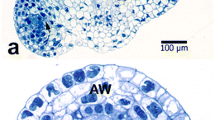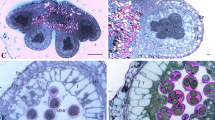Abstract
In this study, cytochemical staining methods were used to follow the cytochemical modifications of microspore cytoplasm and sporoderm in Campsis radicans (L.) Seem. from tetrad stage to mature pollen. Flower buds were collected at different stages of development, and the anthers were fixed and embedded in Araldite. To make cytochemical observations under light microscope, semithin sections were cut and stained with different dyes. Cytochemical methods provided the opportunity to localize the reserve material in the microspore and pollen cytoplasm, to distinguish the different layers of the sporoderm, and to determine its chemical structure at different developmental stages. Microspore cytoplasm contains variable amounts of proteins, lipids, and insoluble carbohydrates at different stages of microsporogenesis. Sporoderm formation starts at tetrad stage by the formation of primexine and is completed at vacuolated microspore stage by the addition of sporopollenin from tapetum. During the vacuolization and enlargement of the microspores, the structure and the chemical composition of the exine are modified. The endexine becomes chemically different from the ectexine. The ectexine is composed of sporopollenin and a small amount of protein, whereas the endexine is composed of sporopollenin, proteins, and traces of polysaccharides.






Similar content being viewed by others
References
Audran IC, Batcho M (1981) Cytochemical and infrastructural aspects of pollen and tapetum ontogeny in Silene dioica (Caryophyllaceae). Grana 20:65–80
Eliseu SA, Dinis AM (2008) Ultrastructure and cytochemistry of Eucalyptus globulus (Myrtaceae) pollen grain. Grana 47(1):39–51
Feder N, O’Brien TP (1968) Plant microtechnique: some principles and new methods. Am J Bot 55:123–142
Franchi GG, Bellani L, Nepi M, Pacini E (1996) Types of carbohydrate reserves in pollen localization, systematic distribution and ecophysiological significance. Flora 191:143–159
Glauert MA, Glauert RH (1958) Araldite as an embedding medium for electron microscopy. J Biophys Biochem Cytol 4(2):191–194
Hansson T, El-Ghazaly G (2000) Development and cytochemistry of pollen and tapetum in Mitriostigma axillare (Rubiaceae). Grana 39:65
Heslop-Harrison J (1971) Wall pattern formation in angiosperm microsporogenesis. Symp Soc Exp Biol 25:277–300
Hesse M, Halbritter H, Zetter R, Weber M, Buchner R, Frosch-Radivo A, Ulrich S (2009) Pollen terminology. An illustrated handbook. Springer, New York
Keijzer CJ (1987) The process of anther dehiscence and pollen dispersal. II. The formation and the transfer mechanism of pollenkitt, cell wall development of the loculus tissues and the function of orbicules in pollen dispersal. New Phytol 105:499–500
Knox RB (1984) The pollen grain. In: Johri B M (ed) Embryology of angiosperms. Springer, Berlin, pp 197–271
Knox RB, Heslop-Harnison JL (1969) Cytochemical localization of enzymes in the wall of the pollen grain. Nature (Lond) 223:92–94
Knox RB, Heslop-Harnison J (1971) Pollen-wall proteins: the fate of intine-held antigens on the stigma in compatible and incompatible pollinations of Phalaris tuberosa L. J Cell Sci 9:239–251
Nepi M, Franchi GG (2000) Cytochemistry of mature angiosperm pollen. Plant Syst Evol 222:45–62
Noher de Halac I, Fama G, Cismondi IA (1992) Changes in lipids and polysaccharides during pollen ontogeny in Oenothera anthers. Sex Plant Reprod 5:110–116
O’Brien TP, Feder N, McCully ME (1964) Polychromatic staining of plant cell walls by toluidine blue. Protoplasma 59:368–373
Pearse AGE (1985) Histochemistry, theoretical and applied. In: Analytical technology, vol 2, 4th edn. Churchill Livingstone, Edinburgh
Piffanelli P, Ross JHE, Murphy DJ (1998) Biogenesis and function of the lipidic structures of pollen grains. Sex Plant Reprod 11:65–80
Regan SM, Moffatt BA (1990) Cytochemical analysis of pollen development in wild-type Arabidopsis and a male-sterile mutant. Plant Cell 2:877–889
Southworth D (1973) Cytochemical reactivity of pollen walls. J Histochem Cytochem 21:73–80
Southworth D (1990) Exine biochemistry. In: Blackmore S, Knox RB (eds) Microspores: evolution and ontogeny. Academic Press, London, pp 193–212
Vithanage H, Knox RB (1976) Pollen-wall proteins: quantitative cytochemistry of the origins of intine and exine enzymes in Brassica oleracea. J Cell Sci 21:423–435
Vithanage H, Knox RB (1979) Pollen development and quantitative cytochemistry of exine and intine enzymes in sunflower, Helianthus annuus (L.). Ann Bot 44:95–106
Acknowledgments
We would like to thank the Scientific Research Fund of Trakya University, which financially supported this study.
Author information
Authors and Affiliations
Corresponding author
Rights and permissions
About this article
Cite this article
Tütüncü Konyar, S., Dane, F. Cytochemistry of pollen development in Campsis radicans (L.) Seem. (Bignoniaceae). Plant Syst Evol 299, 87–95 (2013). https://doi.org/10.1007/s00606-012-0705-6
Received:
Accepted:
Published:
Issue Date:
DOI: https://doi.org/10.1007/s00606-012-0705-6




